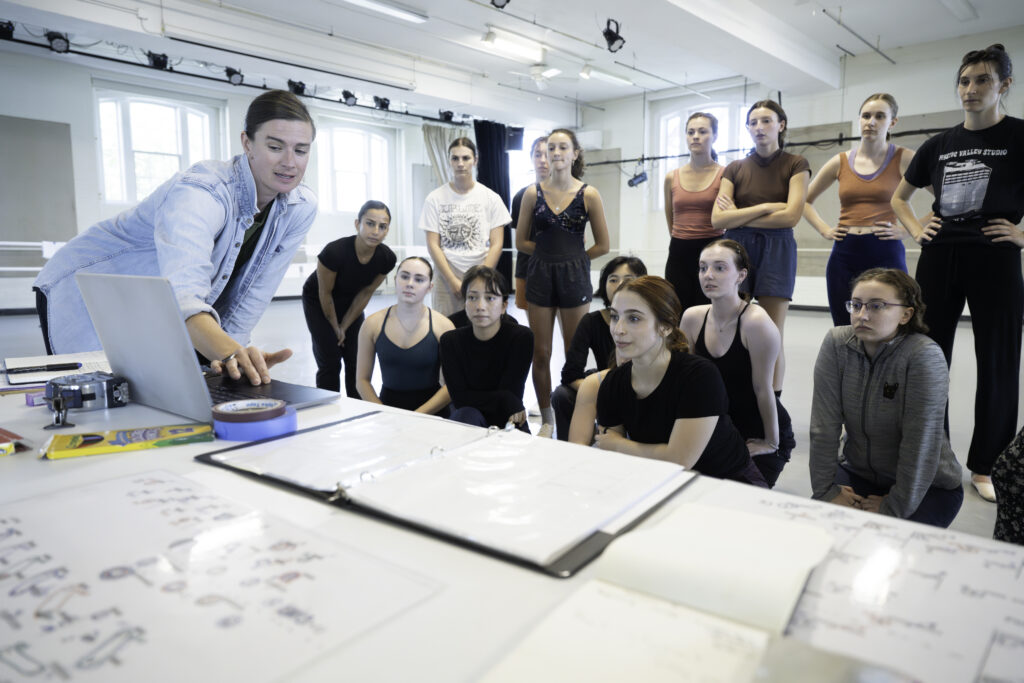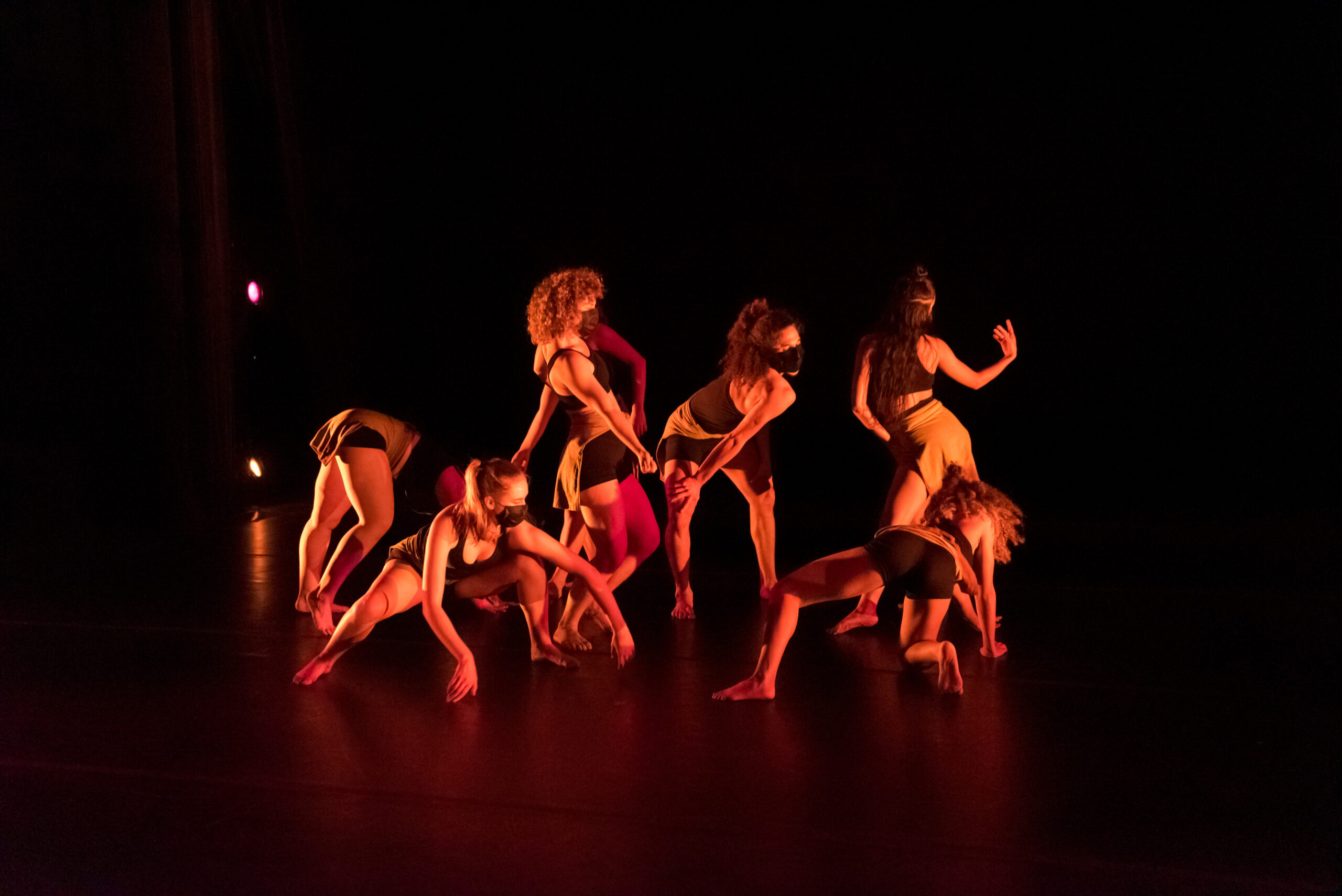Five College Dance Groups Five Distinct Dance Departments Into One Unique Program
It’s a bus ride Emma Lawrence won’t soon forget. She’d just arrived at Smith College in Northampton, Massachusetts, for her second year of school but her first on campus (COVID-19 lockdowns meant a virtual frosh experience). She and two classmates headed to Hampshire College to audition for the restaging of Jawole Willa Jo Zollar’s Batty Moves at Five College Dance. The route was confusing for newbies, and they almost didn’t make it. But Lawrence had a blast auditioning and was picked to participate.
Fast-forward two years and Lawrence, now a senior, arrived again on campus, this time a couple of weeks before classes started, for an intensive for another of FCD’s annual repertory projects: Lucinda Childs’ 1979 Dance 1, with music by Philip Glass and decor by Sol LeWitt. “It’s sort of the other end of the spectrum,” Lawrence says. The iconic postmodern piece is quite different from Zollar’s celebration of Black women’s bodies and beauty in all forms. “My goal for dance throughout college was to chase it as far as I could and see where it could take me,” she says. The wide-ranging repertory works, enabled by the unique Five College Consortium program, played a significant role in that journey.
A Sum Greater Than Its Parts
Five College Dance, like the Five College Consortium, does more together than each institution could alone. The Consortium is a collaboration involving four liberal arts colleges (Amherst, Smith, Mount Holyoke, and Hampshire) and the University of Massachusetts Amherst. FCD similarly serves as a centralizing force for five distinct dance programs. “Some are small and intimate, some are big and grand,” says managing director Melinda Buckwalter. “It challenges the students to find what they want. And maybe what they want is at another campus than they’re matriculated at, but that’s okay.”
For students, professors, and staff alike, the five-fold dance hub is a draw, combining the unique environment of a small liberal arts school (or, in UMass’ case, a large public university with a BFA track) with a diversity of offerings and robust community beyond their campus bubbles. Even next to some of the country’s bigger dance departments, says Angie Hauser, a dance professor and director of the MFA program at Smith, “Five College Dance can really stand up both on the programming level, curriculum level, and the diversity of faculty and forms.”
Students take courses and audition for performance opportunities across all five campuses, with “travel packages” of back-to-back classes organized to simplify schedules. There are professors specializing in everything from ballet to African diasporic dance, as well as joint lectures and master classes from visiting scholars and artists, a shared production management team, and an abundance of shows.
The way students sometimes shuttle back and forth “feels very much of the real world, when you’re doing different gigs,” Hauser says. The annual repertory project in particular—which wouldn’t be possible without pooling resources—gives students a glimpse into professional life. “It probably is the best way we offer our students to feel what it’s like to be a dancer when it’s your job,” Hauser says.
A Repertory Tradition
One of the first things Caitlin Scranton did upon returning from her junior year abroad was slip on her pointe shoes to audition for George Balanchine’s Serenade, a collaboration between Smith and Mount Holyoke in the FCD spirit. A Smith Class of 2005 alum and member of Lucinda Childs Dance Company who visited her alma mater this summer to set Dance 1, Scranton has now been on both sides.

The list of FCD projects in the years since spans styles and decades, featuring major 20th-century works and more recent pieces by contemporary artists. Occasionally, a dance will be reimagined or a new one created for the students. FCD students have performed works by Trisha Brown, Mark Morris, Merce Cunningham, Ohad Naharin, Bill T. Jones, Bebe Miller, and Camille A. Brown, among others.
Championed for years by Jim Coleman, former FCD chair and retired Mount Holyoke professor, the repertory projects allow students to step into the past and present of dancemaking and engage with material in the deep way that preparing for performance demands, Hauser says. Plus, she says, it gives the community a chance to see live works they may only have read about or watched on video.
Childs’ Challenge
Lucinda Childs’ rep has been on the program’s wish list for years. What makes Dance 1 special “is how brilliantly tied to the music it is,” Scranton says. “The patterns and rhythms that Lucinda is able to shape with the way she’s put phrases together is just incredibly beautiful.”
Dance 1 isn’t for the faint of heart. It’s complex and mathematical. It requires dancers to learn movement phrases that feel impossibly fast, then gives them scores that tell them when to enter and with which phrase. They must count Glass’ meter-changing maze of a composition like the fate of the piece depends on it, because it does—the music offers little by way of guideposts if they get lost.
“I have never before been challenged by a dance piece in the way Dance 1 has challenged me,” says May Saito, a junior BFA student at UMass. “After every section we learned, we all felt that it couldn’t get more complicated—and then it did. Even when we aren’t running their cast, everyone stands on the side counting and offering support.”
Scranton had seven days before the fall semester to teach dancers—with all five schools represented—the choreography before leaving them in Hauser’s hands for twice-weekly rehearsals leading up to performances before and after Thanksgiving. “Dance 1 hones your efficiency: You really have to pare down your movement in order to get the task done,” says Scranton, who will return to coach leading up to the performances. “It can transform your dancing. I hope that they soak in that they can do hard things that they maybe think that they can’t do. That nothing is insurmountable.”
On the last day of the intensive Lawrence attended, students did a full run in the studio with a small audience from the FCD community. Professors filtered in as dancers warmed up, got some jitters out, and huddled to review counts. “And then we just did it. When it was over, I personally was shocked,” Lawrence recalls. “I didn’t know that I had it in me. It was triumphant.”




